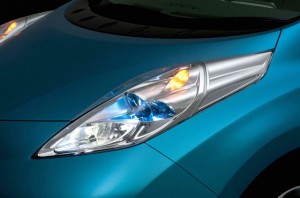You are probably reading this article with the help of the new generation of energy-efficient lighting. Light emitting diodes (LED) are the new standard in backlighting for computer displays, smartphones, iPads, television LCDs, and the navigation/entertainment system displays inside cars.
Last week, I attending Strategies in Light – a major conference organized by Strategies Unlimited, LEDs Magazine, and PennWell. Jed Dorsheimer with Canaccord Genuity stated that 27 percent of global electricity is used in lighting – 4.7 billion kWh for lighting. Most of that electricity is wasted. If you’ve ever felt the burn of replacing an old incandescent bulb that’s still hot, you experienced the inefficiency of most energy lost as heat. LED lighting removes much of the inefficiency.
At her conference presentation, Vrinda Bhandarkar with Strategies Unlimited, projected that LED lighting will grow from $5 billion in 2010 to $20 billion in 2015, with growth continuing at 33% CAGR.
In a car, energy efficient lighting results in better miles per gallon. In an electric car, less electricity demand on the battery pack can result in greater range per charge. LED lighting was first used inside the car for dashboard displays. Now LED lighting backlights the navigation display for the driver and the entertainment system displays for the passengers. The new Hyundai Equus includes an iPad, which use LED backlighting. The new Tesla Model S will offer a 17-inch touch display with LED backlighting for the driver.
The Audi A7 Sportback and Audi A6 offer optional head-up display. Critical data is displayed on the windshield in areas that do not distract from watching the road. Without taking your eyes off the road, the head-up display lets you check your speed, navigation symbols, and assistance systems. The car owner can customize what is displayed. 15 white LEDs are used in the display. There may be an LED backlight head-up display in your future.
At first LED lighting was used in luxury cars from Lexus, Cadillac, and others. As LED prices drop, the efficient lighting is being designed into less expensive cars. LED lighting was first used on dashboard displays, then navigation systems, then outside the car for running lights, taillights, low-beam headlights, high-beam headlights, and now head-up displays.
Aldo Kamper, CEO OSRAM Opto Semiconductors, sees increased car safety with LED lighting supported by intelligent sensor solutions. Head-up display is a current example. Adaptive front lighting systems (AFS) will be used, as will light detection and ranging (LIDAR).
Increasingly, while you drive LED street lights, exit signs, and traffic lights assist you. Even though LED lights are currently pricing, departments of transportations are installing LED lights because of their long-life. With expectations of 50,000 hours of use, labor costs are lowered, as fewer street, park, and outdoor lights require replacement.
In electric cars, LED lighting puts less demand on the battery pack, allowing the driver the stretch the range per charge, especially at night. The Nissan LEAF uses LED lighting both inside and out. The headlights are LED. The Chevrolet Volt limits LED lighting to break lights and interior displays, using halogen for the headlights. Although LED lighting is longer-life than halogen, automotive engineers are cautious about the brightness, quality, and directional coverage in headlamps, especially at high beam.
Automotive engineers are currently designing 2014 to 2016 cars. They are projecting improvements in LED lumens per watt, directionality, and quality of light. They are also getting projections from suppliers of falling prices. LED lighting will increasingly be used in car interiors and exteriors.
As LED prices fall, they are also being used to cut electricity bills at work and at home as they replace old inefficient incandescent bulbs. As I write this article, my office is brightened with LED lights that replaced CFL that replaced incandescent. Yes, I’m an early adopter willing to pay Home Depot $19 per bulb made by Lighting Science Group (disclosure: I currently own stock in LSCG which I bought after installing the lights). Today, it takes a few years in the home to achieve pay for LED with electricity saved; by 2012, a few months; by 2015, bulb prices may match today’s CFL.
Jed Dorsheimer with Canaccord Genuity, a leading research and investment bank corporation, projected that LED lighting will reach 46% (range of 30 to 60%) penetration by 2020 with the following results:
– Revenues of between $105.9B and $313.8B
– Save a cumulative 5T kWh of electricity
– Removing the need for 559 full-sized power plants such as coal plants
– Reduce a cumulative 8.4B tons of CO2 emissions = all of the passenger cars in the world.
– Creates 1.3M jobs and saves over $489B over the next decade
For now, LEDs are a no-brainer car displays, power-hungry mobile electronics, and TV LCDs. With the advantages of energy-efficiency, compact size, ability to change color, be part of intelligent lighting networks, and rapidly falling costs, LEDs will dominate our cars, homes, and workplaces in the future.


Interesting.., part of the reason LED’S are slowly coming to the market at a price more people can afford is very similar to the one entailed by the auto industry. They need time to get the obsolete (technology off the shelves. Incandescent and flourescent lights are going the way of gasoline powered vehicles. Trade-in values will drop horribly over the next few years.
More and more people are using LEDs nowadays. It’s good to know that many markets are making it very available and at a lower cost. LEDs have become the future of lighting not just for cars, but for other things as well. Good read!
@MLO,
Lights are getting more attention and it’s a good thing for safety. On the other hand, those high-intensity lights can be hard for oncoming traffic. –ed.